To which saint should we dedicate ourselves?
The saints are the first organisers of civil and religious society in Brittany. The first saints, hermits and monks arrived alone by the English Channel from the 6th to the 7th century AD. They would have sailed on "stone troughs". Arriving in Armorica, they converted the pagans. They were supposed to tame or kill dragons and wild beasts. Alongside the seven holy founders of Brittany and the bishoprics, there are many saints, all associated with the founding of a parish.
Some of them are still the object of great devotion and are honoured through pardons and processions. Let us find them again without further delay.
Saint Colomban
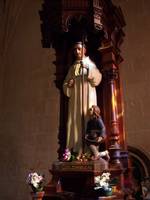
Colomban de Luxeuil (6th c.) was an Irish monk who landed in Brittany, at Saint-Coulomb near Saint-Malo, in the 580's. He evangelized France, Germany, Switzerland, Austria and Italy and created a monastery in Luxeuil. A European network of exchanges, bringing together hamlets and towns, was woven in the footsteps of St Colomban. In monk's habit, he is often accompanied by a dove. It is celebrated on 23rd November.
He never passed through Locminé, but the monks who came from Luxeuil to create the convent established his rule and his cult there. Saint Colomban is celebrated with a pardon at the end of June and his relics have been kept in the church since the 15th century. The Notre Dame du Plaskaer chapel is dedicated to him as well as a fountain.
>> Learn more about friends of saint Colomban
Sainte Noyale
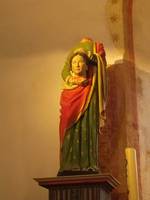
Ste Noyale (Ste Nolwenn in Breton) is one of those 6th century martyrs whose life was not very happy... Daughter of a king of Cambria (Wales) then Celtic, her father wanted to force her to marry; she wanted to consecrate herself to God: so she fled to Brittany and arrived in the village of Bézo. Weary, Nizan, a local tyrant lord, decides to marry her... she refuses, he cuts her neck... is that why she is now invoked against headaches?... She is visible in Bignan, in the chapel of Bézo, or chapel ste Noyale.
Sainte Brigitte
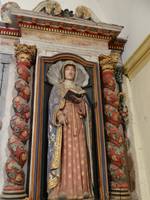
In Breton, Brec'hed or Berhet. Of Irish origin, she is considered one of the patron saints of Ireland. Her cult has spread to Brittany and even to all of Europe.
Born in 453, she refused all suitors attracted by her great beauty. She retired a few miles from Dublin, forming with several of her companions, one of the first female religious communities in Ireland. A woman of great generosity and exceptional energy, she is reputed to facilitate childbirths and to provide milk for women, as well as for sows and sheep. She is depicted in a white abbess dress with a black veil. In Brittany, she is celebrated on the last Sunday of January. In Naizin, a chapel is dedicated to her. Forgiveness takes place in September.
Sainte Barbe
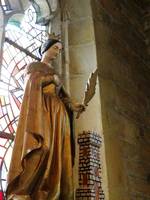
The Bretons also honour the saints of the Universal Church. Among them, ste Barbe is represented with a tower with three windows symbolizing the Trinity. Beard's father, a wealthy pagan, wanted to protect his virginity and prevent him from becoming a Christian. He locked her up in a tower with two windows. A priest, disguised as a doctor, broke in and baptized her. Her father, furious, dragged her before the Roman governor of the province, who condemned her to terrible torments and then had her beheaded by her own father. He died struck by lightning.
Beard is invoked against lightning, anxieties and to ward off fears. He's the patron saint of architects, firemen, miners. The beautiful listed church of Moustoir Ac is dedicated to her.
Saint Michel
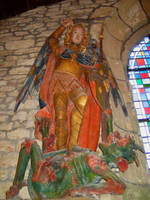
"the most powerful and beautiful of all the Angels in Heaven" is a holy "saurochtone", literally, dragon slayer.
He is represented as a winged archangel, a knight in bareheaded armour, armed with a shining sword, on foot or on horseback, slaying the dragon (allegory of the victory of the Christian faith over evil).
He is the patron saint of many trades, police officers, parachutists, pastry chefs and bakers, fencers, coopers, radiologists and radiotherapists.
In Guéhenno, thechapel of the Mount is dedicated to him. His pardon takes place on the last Sunday of September..
Let's say :
- When the wind is north on St Michael's day, October is dry.
- All the rains lost at St Michael's are returned.
- Kiss on St Michael's day, dry October.
- Rain if St Michael without thunderstorm, of a clement winter the omen.
- When the swallow sees St Michael, winter only comes at Christmas.




